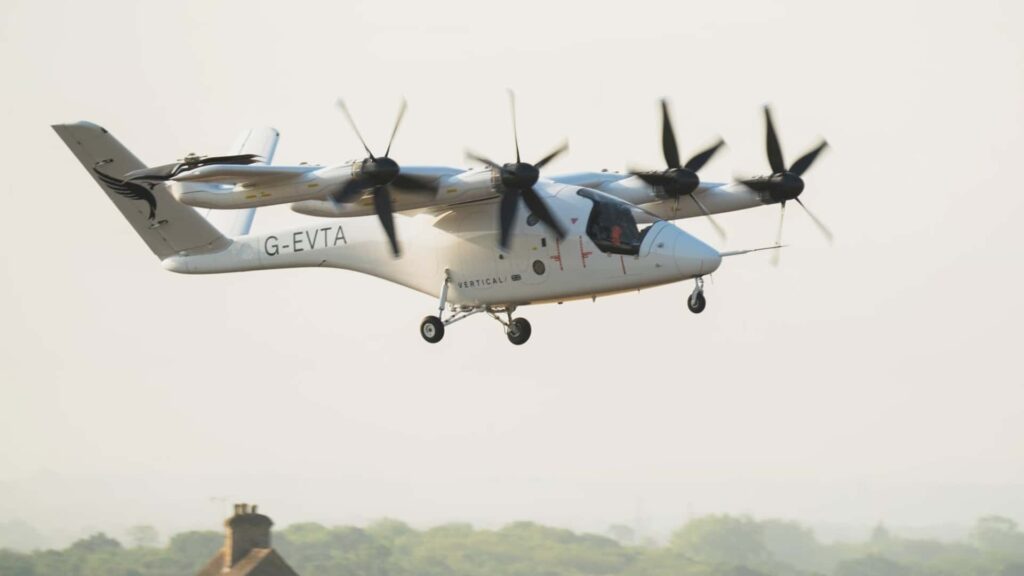UK air taxi startup Vertical Aerospace has achieved a groundbreaking milestone for the eVTOL (electric vertical take-off and landing) industry. The company successfully completed the world’s first airport-to-airport flight with its VX4 electric airplane prototype, showcasing the potential of electric aviation.
On July 16, the VX4 prototype took off from Vertical Aerospace’s test center at Cotswold Airport and flew to the Royal Air Force Fairford station, a distance of 17 miles. This marked the first time a full-scale, piloted winged tilt-rotor eVTOL aircraft designed for commercial service completed a flight between two airports.
The VX4 prototype, powered by a battery, reached speeds of 115 miles per hour and an altitude of 1,800 feet during the flight. The successful airport-to-airport journey demonstrated the aircraft’s capability to integrate with real-world airport operations.
Simon Davies, Vertical Aerospace’s Chief Test Pilot, piloted the VX4 prototype during the historic flight. He emphasized the significance of this milestone, stating that flying the VX4 from one airport to another was a major achievement and a powerful demonstration of the aircraft’s real-world capabilities.
The VX4 electric eVTOL features a fixed-wing configuration with eight propellers, enabling a projected top speed of around 200 mph and a range of up to 100 miles on a full charge. The cruising speed of the aircraft is 150 mph, offering a balance of speed and range for commercial use.
Vertical Aerospace plans to use a CCS connector for DC fast charging of the VX4, although specific charging specifications have not yet been released. The aircraft is designed to accommodate either one pilot and four passengers or cargo, providing flexibility for various transportation needs.
While the VX4 prototype represents a significant advancement in electric aviation technology, Vertical Aerospace acknowledges that the aircraft is not yet ready for mass production. However, the successful airport-to-airport flight demonstrates the progress being made in the development of electric vertical take-off and landing aircraft, bringing us closer to a future of sustainable and efficient air transportation.
The world of technology is constantly evolving, with new devices and innovations being released on a regular basis. One of the most exciting developments in recent years has been the rise of smart home technology. These devices are designed to make our lives easier and more convenient by allowing us to control various aspects of our homes with just the touch of a button or a simple voice command.
Smart home technology encompasses a wide range of devices, from smart thermostats and lighting systems to security cameras and door locks. These devices are all connected to the internet, allowing us to monitor and control them remotely using a smartphone or other internet-connected device. This means that we can adjust the temperature in our homes, turn lights on and off, and even unlock our doors from anywhere in the world.
One of the most popular smart home devices is the smart thermostat. These devices are designed to learn our heating and cooling preferences and adjust the temperature in our homes accordingly. This not only helps to save energy and reduce our utility bills, but also ensures that our homes are always at the perfect temperature for our comfort.
Another popular smart home device is the smart lighting system. These systems allow us to control the lights in our homes remotely, either on a schedule or in response to our movements. This can help to improve home security by making it look like someone is home even when we are away, as well as creating a more comfortable and inviting atmosphere in our homes.
Smart home technology also includes devices that can help to improve home security. For example, smart security cameras can be placed around our homes to monitor for any suspicious activity. These cameras can send us alerts and notifications if they detect any movement, allowing us to take action immediately. Similarly, smart door locks allow us to lock and unlock our doors remotely, as well as provide access codes to family members or guests.
Overall, smart home technology has the potential to revolutionize the way we live our lives. These devices can help us to save time, energy, and money, as well as provide us with a greater sense of security and peace of mind. As technology continues to advance, we can expect to see even more exciting developments in the world of smart home technology in the future.

